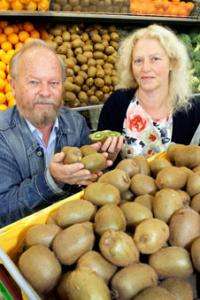Research confirms Chinese origin of NZ's PSA outbreak

University of Otago scientists have today published persuasive evidence that the PSA strains responsible for the outbreak in North Island kiwifruit orchards came directly from China, as did those responsible for the 2008 Italian and 2010 Chilean outbreaks of the devastating canker disease. This result will help clarify the pathway by which PSA entered New Zealand.
Associate Professor Russell Poulter, Professor Iain Lamont and Dr Margi Butler, all from the University's Department of Biochemistry, had been working with the New Zealand kiwifruit industry since mid-2011. The PSA (Pseudomonas syringae pv. actinidiae) bacterium was first detected in a Te Puke orchard in November 2010.
Their research, which involved DNA detective work using advanced genomics technology, appears today in the leading international journal PLOS ONE.
To analyse the geographic origin of PSA the researchers completely sequenced and compared the genomes of PSA strains from Japan, Chile, China, Italy and New Zealand. The analysis also used sequences present in public databases. The new sequences, which have been added to the public database GenBank, are the first New Zealand and Chilean PSA strains to be sequenced.
Dr Poulter says the team found that the core genomes of the Chinese, Chilean, Italian and New Zealand strains were almost identical and likely shared a common ancestor around 10-15 years ago. However the genome sequence demonstrates that the New Zealand strains are a distinct clone. The Italian strains form another geographical clone.
"These findings paint a clear picture of an independent Chinese origin for both the Italian and the New Zealand outbreaks and suggest the Chilean strains also come from China," says Dr Poulter.
The researchers are now sequencing a further 20 strains, mostly from China but also Korean and Turkish strains. The researchers are focusing particularly on a type of mobile element they have detected in the PSA genome. These mobile genetic elements (termed ICE or 'integrative conjugative elements') can transfer between cells of different bacteria strains and alter properties such as their infectiousness and resistance to antibiotics.
Three distinct ICEs were identified by the team. The first was shared by the New Zealand strains and three strains from China. Another ICE was shared by Italian strains and a Chinese strain, while a third ICE was found in the Chilean strains.
"Some PSA may be inherently more virulent due to the particular ICE they carry. This has worrying implications as strains of kiwifruit that are resistant to one type of PSA might not be resistant to another. This means strict border control by kiwifruitproducing countries is more important than ever," says Dr Poulter.
More information: Butler, M. et al. Pseudomonas syringae pv. actinidiae from Recent Outbreaks of Kiwifruit Bacterial Canker Belong to Different Clones that Originated in China. PLOS ONE. dx.plos.org/10.1371/journal.pone.0057464
Visit the New Zealand Genomics website for more information.
Journal information: PLoS ONE
Provided by University of Otago
















